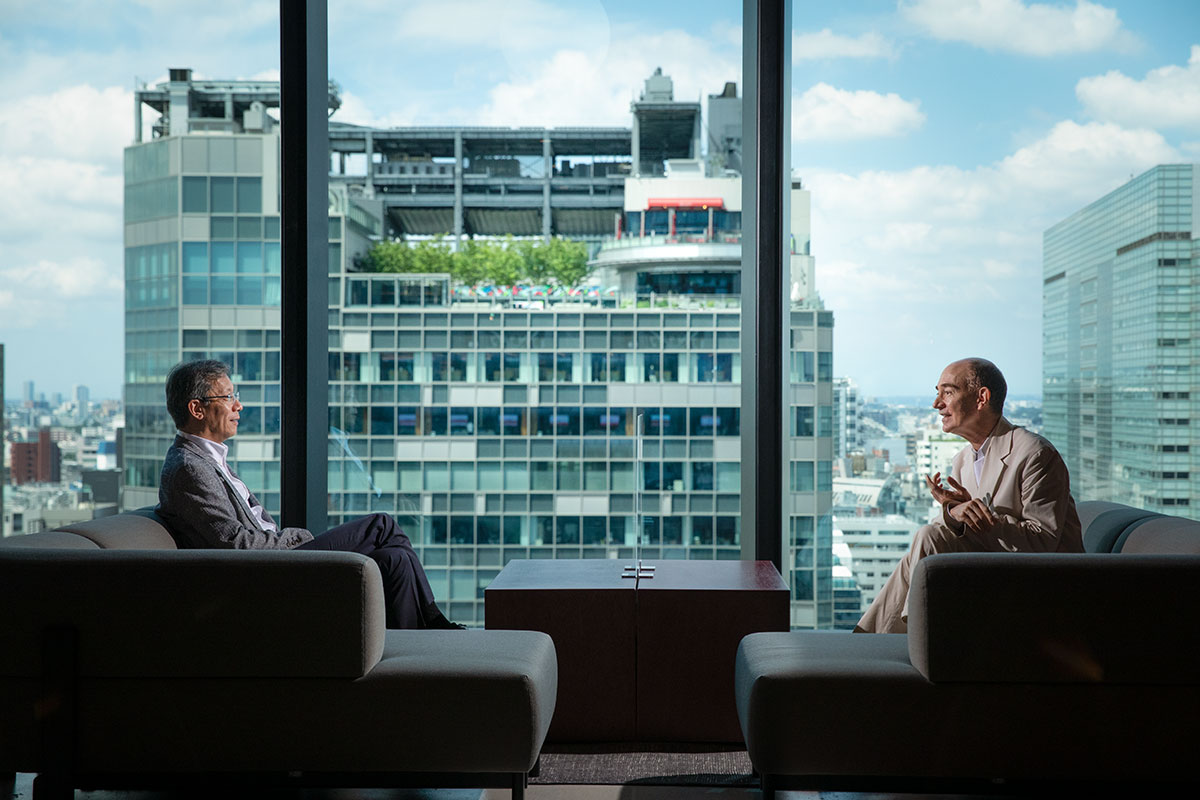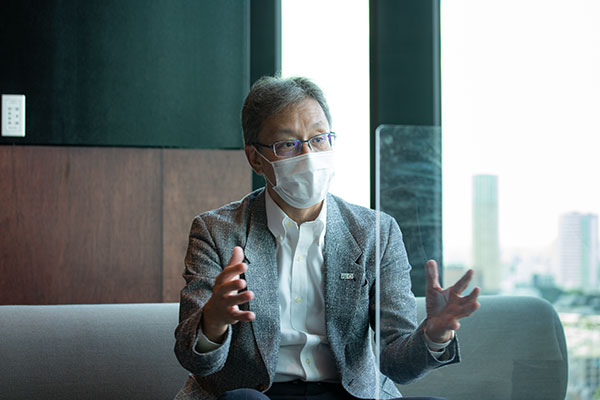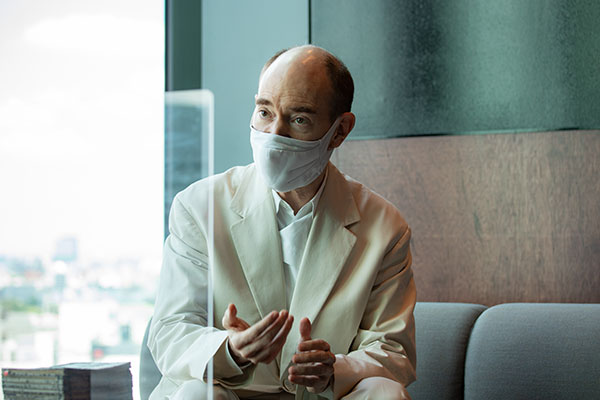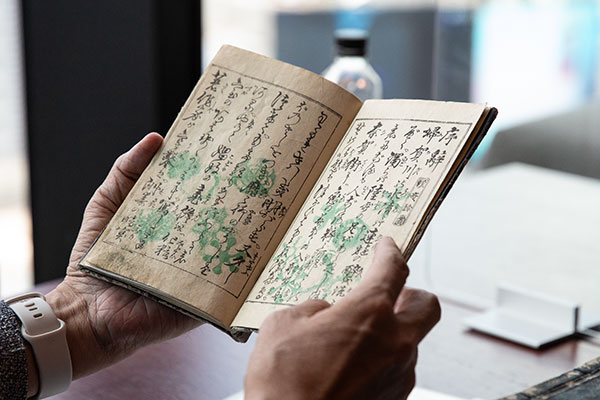Society, dialogue, and empathy: Toward a resilient and inclusive University Finding common ground between two researchers specializing respectively in ocean engineering and Japanese literature

Society, dialogue, and empathy: Toward a resilient and inclusive University
For this first presidential dialogue feature since President Fujii’s inauguration, our new president, with his emphasis on “dialogue and empathy,” wanted to sit down with the Japanese literature scholar Robert Campbell. The dialogue took place in central Shibuya, not far from the Komaba Campus, where both have spent much of their research lives. As their dialogue proceeded, the two scholars leafed through Edo period woodblock printed books brought by Campbell. The world of the experts is becoming accessible to the wider public. From the words of these two researchers with different specializations, a shared sensibility emerged. (Dialogue took place on July 21, 2021)

A fine balance between logic and empathy in a congratulatory address at a matriculation ceremony
- Fujii: Professor Campbell, I’ve wanted to have a chance to speak with you since I heard your speech at the 2018 Matriculation Ceremony. I was impressed by what you said in your congratulatory address about moving back and forth between the two cultures of America and Japan. Although I’ve made big changes to my own fields of specialization over my research career, in most cases I was glad that I did. I often tell students that they should not hesitate to cross boundaries. In your congratulatory address, you spoke of the “fine balance” between logic and empathy. When advancing dialogue, I feel that, rather than speaking from a place of initial empathy, what is more important is for empathy to spread while actively facilitating the dialogue forward. In a speech you gave at a symposium held at Chubu University this past May, you spoke of how difficult it is to use the word “empathy.” I would very much like to hear more from someone who has thought so deeply about empathy while moving back and forth between cultures and spheres of language, and who has deeply considered empathy.
- Campbell: I took early retirement from the University of Tokyo in March 2017 to move to the National Institute of Japanese Literature (NIJL). It was around that time that I was approached to take on the important role of delivering the congratulatory address at the Matriculation Ceremony, which made me realize what a hard taskmaster the University of Tokyo is to its staff (laughs).
- Fujii: Thank you for stepping up once again!
- Campbell: My research proceeds empirically in line with classical literature. However, the majority of pre-Meiji era literature is written in a running cursive style (called kuzushi-ji) that cannot be read by contemporary Japanese speakers. My stance is to survey old literature in the original texts and then, through the work of rendering these comprehensible to a contemporary audience, to discuss and study the contents further with people from various fields. However, this does not mean that I empathize with everything written in these texts. Obviously, there are some parts that are difficult to identify with as a human being living in the 21st century. Conversely, being strung along by questions of identity can lead to readings that don't fit the historical context. There’s nothing more dangerous than empathy without evidence. When crossing boundaries, I feel that it’s important to objectively grasp and understand one’s own given conditions, as was noted by Professor Chizuko Ueno in her congratulatory address at a Matriculation Ceremony in another year.

Graduated in 1988 from the University of Tokyo’s Faculty of Engineering. In 1993, he received his Ph.D. in engineering after completing a doctorate at the Department of Marine Engineering in the University of Tokyo’s Graduate School of Engineering. He has served as an assistant professor at the Institute of Industrial Science (IIS), as a research fellow at the Institute of Physical and Chemical Research (RIKEN), and as the director of IIS, and after serving UTokyo in various administrative roles including executive director and vice president and executive vice president, became president of the University of Tokyo in April 2021. His areas of specialization include Applied Microfluidic Devices and Ocean Engineering.
- Fujii: To ascertain your own position, it’s also important to get to a place where people have backgrounds that are less familiar, rather than to be in the middle of a homogeneous group. When I go into a different field, I tend to be at a loss at first in terms of how to use that field’s terminology, but I’ve often felt that my ideas, which come from a different background, are new and unique in that context. I’ve also had the feeling of enjoying that “sense of bewilderment.” While it’s important to become thoroughly knowledgeable in one’s own field, I’ve come to think that it’s also important for researchers to make forays into worlds they do not know.
- Campbell: In your own career, I expect that part of why you were able to branch out into different fields was because you already had a solid trunk at your core. When I first came to Japan as a foreign student at the age of 20, I remember being told by a certain teacher that it’s important for people in their 20s to keep beavering away – it doesn’t matter at what – until something strikes a chord. I think there’s a wide world waiting once you’ve established a disciplinary base comparable with those of other researchers in existing academic fields.
- Fujii: In my case, that was how it was in the field of marine engineering.
- Campbell: Since my days at the Komaba Campus, I’ve kept abreast of studies in the field of tojisha kenkyu – which involves studies by and with persons with disabilities – at UTokyo. Activities such as utilizing accessible design and providing support for people with visual and hearing impairments are attracting attention worldwide, as well as being linked to innovation. In this context, I hope to see further research and outreach focused on sexual minorities. There’s already a solid theoretical foundation in place. And it would be desirable for this to be brought into view and given substance.
- Fujii: Right. And I think it would be great if the further spread of tojisha-kenkyu would spur developments in areas around persons without disabilities, as well.
- Campbell: First, it’s necessary to gather basic data that shows the reality of the situation. That is the premise underlying movements in scholarship, movements in public opinion and movements in politics. Feminism is a prime example – it has led to the emergence of so many new methods and theoretical systems. Until not long ago, my motto was to try to find an equilibrium without changing the system, but now I feel that we should actively engage in shaping discussions with consideration given to systems design from the outset. With the spread of movements like BLM and #MeToo, now is our chance. This is an area that I’d like to see strengthened.
- Fujii: There’s an initiative called Beyond AI being promoted through a collaboration between the University of Tokyo and SoftBank, part of which is a project that combines tojisha-kenkyu with the study of artificial intelligence (AI). Professor Shinichiro Kumagaya from the Research Center for Advanced Science and Technology (RCAST) has joined a team led by Professor Yukie Nagai from the International Research Center for Neurointelligence (IRCN) to take on the important issue that AI-enabled services and systems tend to neglect minorities. They are aiming at social designs calibrated to make the most of individual character, and I’m keen to see what kind of results they will come up with.
A lot of important information in literature beyond the textual
- Campbell: At the NIJL, we’ve been working with AI researchers to build and maintain a database of 300,000 historical texts and at the same time make their images and metadata machine-readable. There’s a lot of information in books that cannot be gleaned by looking only at the text. For example, if you look at the cover, based on the material, its heft, its color and these finger marks, we can tell if a book came from a type of lending library known as a kashihonya. There are things we can tell from this material aspect, such as the kind of people who read a certain book – where they were from and what their social position was. And then the illustrations are another important element. Today, I’ve brought along these woodblock printed books, which we call hanpon, that were published in the Tempo era (1830-1844) of the Edo period.
- Fujii: Can I hold them?
- Campbell: Of course. Shungyo Hachiman gane is a conversational novel set in the so-called pleasure quarters of Fukagawa. Although the landscapes depicted in its illustrations no longer exist, we can glean various things from them. Nanka no yume is a polychromatic printed work that combines elements of a novel and an essay, and the names that appear in it are those of actual culturati. It contains a wealth of information in a form that is disconnected from our own contemporary paradigm. For the people of Edo, botany, military tactics, Japanese mathematics and rules for healthy living were all the same in that they were things to read. The classification of literature that was developed in places like the United Kingdom in the 19th century does not apply to books from Edo. Diaries left behind by Japanese people from the 9th century on are also incredibly valuable, and give us information on topics such as the celestial bodies and weather observed at that time, on the ocean and even fishing. Academically, it would be extremely instructive to be able to share literature that reflects the society of that era with researchers in various fields.
- Fujii: Reading old literature gives rise to academic developments that have their own various colorings, would you say?
- Campbell: We've also got a responsibility to continue developing it. For about the last 10 years or so, an academic association that I belong to has been running a class titled “Wahon Literacy” that teaches elementary and junior high school students how to read kuzushi-ji or premodern cursive script texts.
- Fujii: While a database of historical literature is of course important as research material, there’s also meaning in sharing that with society, isn’t there? The process itself is incredibly valuable. I feel that the two-way interaction between researchers and the public will lead to understanding and empathy toward universities and academia. What could we do to facilitate that?

Robert Campbell
Graduated in 1981 from the University of California, Berkeley. In 1992, he received a Ph.D. in literature after completing a doctorate at the Department of East Asian Languages and Civilizations at Harvard University. Before taking a position as University Professor at Waseda University in April 2021, he has served in various positions including as a full-time lecturer at the School of Letters at Kyushu University, associate professor at the National Institute of Japanese Literature (NIJL), associate professor and then professor in the Graduate School of Arts and Sciences at the University of Tokyo, and the Director-general of NIJL. His most recent publication is Nihon koten to kansensho (“Infectious Diseases in Premodern Japanese Literature”) (Kadokawa Sofia Bunko, March 2021). He is a specialist in early modern and modern Japanese literature.
- Campbell: Something we thought of at NIJL is for these activities to be fed back into research. I also think these activities have the power to shake research from its very roots, and to give it a boost of energy. I was interested in seeing what would happen when the literature and the database were used expressively, so we established an artist-in-residence program. An animator created a short film inspired by a book by Keisai Kuwagata (1764–1824), which had a significant effect on the academic perspective of the researchers who consulted on the project, from the standpoint of seeing the pictures together with the text.
- Fujii: I hear you. I set up the Design Lab during my tenure as the director of UTokyo’s Institute of Industrial Science. We brought in designers to meld engineering with design. We sought out technologies that would realize people’s visions of the future, and we found that making progress with efforts to show how technologies thoroughly investigated by engineering could be used in scenarios in everyday life had a major impact on the research, which led to the birth of a variety of projects.
- Campbell: By the way, the Waseda International House of Literature, which opens this October at Waseda University, where I’m a university professor, holds a massive collection of Haruki Murakami’s books, manuscripts and audio records.
- Fujii: How will the records be used?
- Campbell: We’ll set up an audio room and listening booths and hold workshops mediated by music. The songs and liner notes from the albums that Murakami played in the jazz coffee house he opened while he was a student will be a valuable testimonial about the 1970s and the decades before. We hope to make it a place where people can study and converse across genres. At the time of the Great East Japan Earthquake, I held a reading club for evacuees. It’s not easy for people who have no contact with literature to talk about books with others, but I’ve found it to be extremely important that we all approach and talk about the worlds that we find unfamiliar. Getting otherwise reserved people to laugh and open up – literature has that kind of power. I also think that music is a medium that can bring people together without forcing them to clarify their beliefs and ideas.
I feel that universities are in large part necessary as places where people will be able to spend time with a sense of security, where they can catch their breath. I would like the University of Tokyo to act, even ahead of Japanese society in general, to attract energetic people from overseas. Since I research Japanese literature, I was naturally drawn to Japan, which has a lot of materials, but I’d also like to see people in other fields take precedence in receiving recognition and support from UTokyo.
A desire to create methods to amplify the voices of those who are not in the majority
- Fujii: I’m currently continuing a series of dialogues with other members of the University, and the other day I conducted a dialogue in English with members who were not Japanese speakers. Faculty members from overseas, including the language teachers at Komaba, are a minority on our campuses. I feel that we have to create methods to amplify the voices of those who are not in the majority.
- Campbell: And I hope you will be able to reflect what you hear into the course of action that you take. University reform mustn’t be heteronomous, you know.
- Fujii: Autonomy and spontaneous initiative are certainly important, as well as thinking and changing for oneself. I’d like to build with concrete actions. Since the University of Tokyo is such a large organization, dialogue on campus is also important. That being said, dialogue takes time and effort. I wonder if there is a good way to promote dialogue in a university organization that has such a large number of people just on campus.
- Campbell: In a sense, I feel that there’s an important role for contingency. NIJL is located in Tachikawa, in the same building as the National Institute of Polar Research and the Institute of Statistical Mathematics. The seeds of research are sometimes planted when researchers from these different fields pass by each other in the corridors. A chance conversation between an aurora researcher and a scholar of classical literature that happened in the smoking vestibule led to the discovery that a 13th century diary by Fujiwara no Teika, Meigetsuki (“Record of the Brilliant Moon”), contained a description of a low-latitude aurora. But then, the president is only one man, after all (laughs).
- Fujii: The use of digital technologies is also important. I’ve heard that you are taking full advantage of digital tools to reach a wider audience.
- Campbell: I set up my own TikTok account. Social media is often seen as being diametrically opposed to academia, but I don't agree with that. I post 20 TikTok video clips a month, each with a slight element of learning. We dropped in on a merchant site in Ginza to make a video that captures elements including social issues, budding innovation and local history. The other day, at a shop specializing in wagashi, a Japanese style of confectionery, I talked about the historical gift economy using the example of dorayaki (a kind of pancake stuffed with red azuki bean paste). I think researchers should pay more attention to the broadcasting power of social media.
- Fujii: It’s true that exhibiting interactivity can be difficult when just posting on a website. Another thing we are considering is that it might be a good idea to change our use of the term “public relations” (koho). I feel that we may be able to change the way things are so that interactivity is more visible, rather than just the University putting out information it wants to people to see.

- Campbell: Public relations is certainly important. The leaves on shoots that bud from the base of a tree may prove to be the basis of subsequent innovation. I think that traditionally, university public relations was meant to disseminate the research findings of individual departments, but now it should be more "relational" oriented in such a way that it makes its way into the organization of its own accord.
- Fujii: That will be something to definitely consider in the ongoing campus discussions.
- Campbell: Japan is a leading maritime state. The problems of microplastics and the sustainability of marine products and other foods are themes where it can make a major contribution. Now that you’ve become the president of UTokyo, I expect you will be sending a strong message on marine issues.
- Fujii: Up to now, marine science was performed by specialists using advanced instruments, but I’d like to extend this to non-specialists. For example, the OMNI Project is something we launched as a new marine research initiative in which citizens explore and share their knowledge about the sea. We have built simple observational instruments and have continued to hold workshops to think about these issues together with people who are interested in the ocean, including junior and senior high school students, fishery managers, anglers and surfers. Since experiencing these kinds of activities should enable even people for whom the sea is far removed from their daily lives to consider themselves as having a stake in the sea, I have high expectations for this project.
- Campbell: As a keen SUP [standup paddle boarding] enthusiast, I’m often on the water. I’d love to install an OMNI sensor on my board as well.
- Fujii: By all means, thank you very much. I’ll be sure to check out your TikTok account, too.
Located on the 15th floor of Shibuya Scramble Square, SHIBUYA QWS is an activity hub at which members including six universities with campuses in Tokyo (UTokyo, Tokyo Institute of Technology, Keio University, Waseda University, Tokyo City University and Tokyo University of the Arts) as well as corporations, collaborate to create new values for the future. shibuya-qws.com
Photos: Junichi Kaizuka
* This article was originally printed in Tansei 43 (Japanese language only). All information in this article is as of September 2021.






